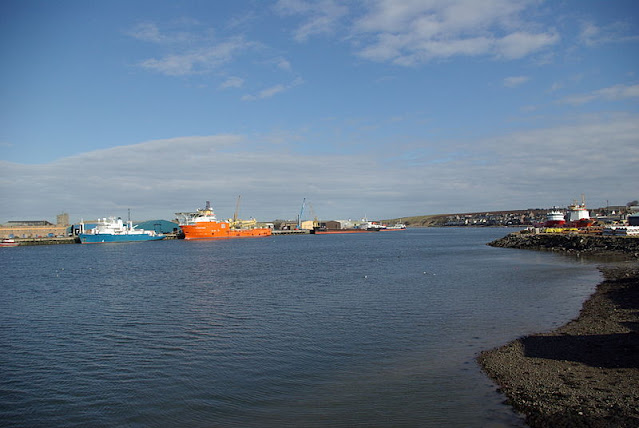From Newtonhill, the approach to Aberdeen is marked by a series of small villages: Downies, Portlethen, which has become a residential area for commuters to Aberdeen, and Findon (aka Finnan), home of a variety of smoked fish called Finnan Haddie.
James Boswell and Samuel Johnson, who we last met slagging off a waiter at their inn in Montrose (see 8 December) had a much more positive experience on their arrival at Aberdeen, where the Lord Provost invited them to the Town Hall and bestowed on Johnson the freedom of the city. They also visited the English Chapel, where "the congregation was numerous and splendid".
The modern-day Aberdeen is dominated by the North Sea oil industry, as can be seen from the many oil-platform supply vessels crowding the harbour. The harbour's other functions include fishing, fish-processing and general trading, and it is also a departure point for
ferries to Shetland and the Orkneys. Aberdeen's sandy shore has an 18-hole golf course called the
Kings Links running alongside it. The city's
museums include a Maritime Museum, housed in Provost Ross's House on the historic street known as Shiprow, an art gallery and Provost Skene's House, which resembles a castle more than a mere house. Aberdeen is often referred to as the Granite City, since granite features heavily in the city's impressive architecture, for example in the Marischal College, founded in 1593, which forms part of the University and has a museum which tells the story of the college's history. In fact, this learned city has two universities: the University of Aberdeen and Robert Gordon University, though the latter has only had university status since 1992.
The part of the city known as Old Aberdeen was once a separate Burgh and from the late Middle Ages was an important political, ecclesiastical and cultural centre. Many of the old buildings in this part of the city form part of a conservation area.
King's College, which used to be a separate university, is located here. Its chapel dates from the 15th century, and has an impressive tower topped with an "imperial crown", a recreation of the original 17th century crown, which was lost during a storm.
St Machar's Cathedral is also in Old Aberdeen; in spite of its name it is strictly speaking a "high kirk", since it is no longer the seat of a bishop.
For a list of events in Aberdeen, see
here.
Webcam view of Aberdeen Beach.
Map of the area.
 |
| Old Marine Operations Centre, Aberdeen - geograph.org.uk - 1958623. Photo by Greig Ritchie, via Wikimedia Commons. |














